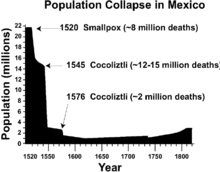Cocoliztli epidemics

The Cocoliztli epidemics were a group of times many people in New Spain became sick.[1][2] New Spain is Mexico and parts of South America today. The Cocoliztli epidemics were in the 16th century. Today, scientists do not know which germ caused the sickness. There may have been a few different germs. People had fevers and bled from their ears and noses. The Aztecs called this disease "Cocoliztli." The epidemic is divided into two groups, causing a total of 7 million to 17.5 million deaths. It was one of the deadliest epidemics in history and the worst epidemic in Mexican history. The first wave of epidemics broke out from 1545 to 1548, killing 5 to 15 million people (about 80% of the Mexican people); the second wave of epidemics broke out from 1576 to 1578 Between 2 and 2.5 million people died (approximately 50% of Mexico's people). Some historians believe that the epidemic may have been smallpox, typhus or measles, but none of these match the symptoms people had. Some people think this epidemic was a viral hemorrhagic fever, which was made worse by the severe drought at that time. Today, scientists think Salmonella was at least one of the germs brought to North and South America by the European colonists.
Name[change | change source]
The word cocoliztli comes from the Nahuatl word for "pest" or disease, illness, and plague.[3]
References[change | change source]
- ↑ Rodolfo Acuna-Soto; David W. Stahle; Matthew D. Therrell; Richard D. Griffin; Malcolm K. Cleaveland (November 1, 2004). "When half of the population died: the epidemic of hemorrhagic fevers of 1576 in Mexico". FEMS Microbiology Letters. 240 (1): 1–5. doi:10.1016/j.femsle.2004.09.011. PMC 7110390. PMID 15500972.
- ↑ Rodolfo Acuna-Sato; David W. Stahle; Malcolm K. Cleaveland; Matthew D. Therrell (2002). "Megadrought and Megadeath in 16th Century Mexico". Emerg Infect Dis. 8 (4): 360–362. doi:10.3201/eid0804.010175. PMC 2730237. PMID 11971767.
- ↑ Zhang, Sarah (2018-01-15). "A New Clue to the Mystery Disease That Once Killed Most of Mexico". The Atlantic. Retrieved 2021-05-06.
